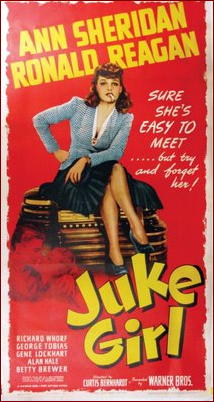April 2010
Monthly Archive
Tue 27 Apr 2010
Posted by Steve under
ReviewsNo Comments
IT’S ABOUT CRIME
by Marvin Lachman
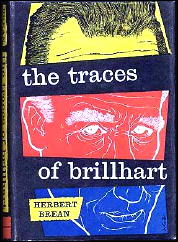
HERBERT BREAN – The Traces of Brillhart. Harper & Brothers, US, hardcover, 1960. Willliam Heinemann, UK, hc, 1961 (shown). Paperback reprints include: Collier, 1965; International Polygonics, 1988.
I thought I was reading The MYSTERY FANcier again when I read Herbert Brean’s The Traces of Brillhart and found he had a detective whose first name is Bill and who is called “Deac.”
This winner of the Bill Deeck sound-alike contest is Bill Deacon, a magazine journalist, like his creator. Brean’s first series character, Reynold Frame, had the same profession. He appeared in four undeservedly forgotten books, including Wilders Walk Away, one of the best first mysteries ever.
The Traces of Brillhart is a good puzzle about a sleazy musician who keeps dying and returning to life (without the help of anything supernatural), keeping the reader off guard until the end. As Deacon says, “I felt surrounded by Brillhart. He was dead but he was everywhere.”
The ending is not as good as it might be, leaving some unraveled threads. Still, this is a fine book, even if Deacon’s girl friend is called “Twit-Twit.” As Jack Paar used to say, “I kid you not.” (Her real name is Twickenham.)
– From The MYSTERY FANcier, Vol. 13, No. 3, Summer 1992.
Tue 27 Apr 2010
Posted by Steve under
ReviewsNo Comments
THE BACKWARD REVIEWER
William F. Deeck
CAROL KENDALL – The Black Seven. Harper & Brothers, hardcover, 1946. John Lane/The Bodley Head, UK, hc, 1950.
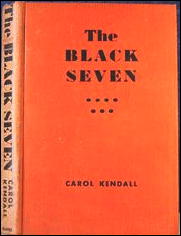
First of all, Tobias Twigg was too mean to commit suicide. He also enjoyed his family, particularly tormenting them and observing how Twigg-like they were turning out to be. But die of poison by his own hand he did, or so the authorities conclude.
Five years later, Casper Twigg, following closely in his father’s footsteps, gathers the more or less odious Twigg family together to announce that he has been accumulating “the follies, the foibles, the flagrancies — or better still, the outcroppings of Twiggisms.”
He is particularly interested in the disappearance of the Seven Black Babies, whatever they may have been, following his father’s death.
Roderick Random — no, not that Roderick Random — twelve years old, exceedingly precocious, and better known as “Drawers,” has set up a home away from home in a shed on the Twigg Terrace property. Thus he is involved in the excitement and the deaths caused by Casper Twiggs’s embracing of a new way to amuse himself.
Indeed, Drawers finds the first corpse on his adopted premises and discovers the meaning of the Seven Black Babies.
Drawers unmasks, almost literally, a murderer in this well written and amusing novel. The author is convincing in her portrayal of Drawers’s intelligence, along with the youth’s corresponding lack of common sense.
However, some doubts, at least on this reader’s part, do arise in regard to the boy’s keen interest in pornography and corresponding apparent uninterest in and possibly repugnance to sex.
– From The MYSTERY FANcier, Vol. 13, No. 3, Summer 1992.
Bibliography: [Taken from the Revised Crime Fiction IV, by Allen J. Hubin.]
KENDALL, CAROL (Seegar). 1917- . Series character: Roderick “Drawers” Random. Setting in each: Ohio.
The Black Seven (n.) Harper 1946; Lane, 1950.
The Baby-Snatcher (n.) Lane 1952.
From Contemporary Authors:
“Carol Kendall is best known for her award-winning children’s books The Gammage Cup and The Firelings. A writer with diverse interests and abilities, Kendall has collaborated with Yao-wen Li on translations of Chinese folktales in Sweet and Sour: Tales from China and has retold six stories of Japanese origin in Haunting Tales from Japan.”
Tue 27 Apr 2010
Reviewed by MIKE TOONEY:
AGATHA CHRISTIE – And Then There Were None. Washington Square Press (Pocket Books), hardcover, July 1973; 173 pages. ISBN 0-671-70466-4.
If you haunt used book stores (ever dwindling numerically) like I do, you occasionally come across something unexpected. Such was the case with this particular edition of an Agatha Christie novel:
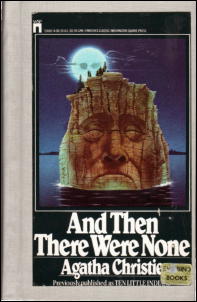
This is a hardcover version of the mass-market paperback (and there is no mention anywhere in this edition of the book’s original, politically incorrect title).
What makes this version special is the 48-page “Reader’s Supplement” inserted in the middle of the text. Clearly, the supplement is aimed at students, probably in high school.
The supplement breaks down as follows:
1. Portrait photo of Agatha Christie (1 page)
2. “Biographical Background” (3 pages)
3. “Historical Background” (2 pages)
4. “Pictorial Background” (22 pages)
5. “Visual Glossary” (2 pages)
6. “Literary Allusions and Notes” (5 pages)
7. “Critical Excerpts” (13 pages).
“Pictorial Background” (all photos are B&W and grainy):
“A View of the Terraces at Torquay” – “Agatha Christie with Her Husband at Their Devonshire Home” – “A Third-class Coach on an English Train” (sketch) – “A Striking View of the Plymouth Shoreline” – “The Devonshire Countryside” – “An English Village Similar to Sticklehaven” – “A Flashy Sports Car of the Period” – “The Occupants of the Motor Boat to Indian Island” (scene from the 1945 movie) – “A ‘Correct’ English Butler” (sketch) – “Harley Street, London, Where Numerous Doctors Practice” – “The Guests Enjoy Their First Dinner” (1945 movie) – “A Gramophone—1905” (sketch) – “A British Courtroom Scene” – “Some of the Guests on the Terrace” (1945 movie) – “A Rocky Coast in Devonshire” – “Vera and General MacArthur at the Shore” (1945 movie) – “A Tea Tray and Service” – “Another Shocking Warning” (1945 movie) – “The Latest Victim” (1945 movie) – “The Last Two Survivors in a Showdown” (1945 movie) – “… And Then There Were None ….” (1945 movie) – “Scotland Yard, Viewed from Westminster Bridge—1940s”.
“Visual Glossary” (artist’s sketches):
Cosh, truncheon, stiletto, torch, grandfather chair, siphon, gimlet, heliograph.
“Literary Allusions and Notes”:
Thirty-seven entries including “cairngorm,” “trional,” “pukka sahib,” “red herring,” “chloral,” “Caesar’s wife,” and “had one over the eight.”
“Critical Excerpts” (published comments from critics of various eras about mystery fiction, including a few about this particular book — and how many of these people have you heard of?):
R. Austin Freeman (1924) – Willard Huntington Wright (1927) – Dorothy L. Sayers (1928) – George Godwin (1929) – P. G. Wodehouse (1929) – Ronald A. Knox (1929) – H. Douglas Thomson (1931) – Stephen Leacock (1939) – Times Literary Supplement (1939) – The Spectator (1939) – Ralph Partridge (1939) – M. L. Prevost (1940) – Will Cuppy (1940) – Marian Wiggin (1940) – Saturday Review of Literature (1940) – Isaac Anderson (1940) – The New Yorker (1940) – The Pocket Book of Great Detectives (1941) – Edmund Crispin (1961) – Fredric Wertham, M. D. (1926) – Current Biography (1964) – Harry Shefter (1964) – Colin Wilson (1969).
The characteristically arch Wodehouse excerpt comes from his article “About These Mystery Stories” in the Saturday Evening Post (1929):
“For the mystery novel Suspicion Handicap, the field is limited. You know it wasn’t the hero or the heroine who did the murder. You are practically sure it couldn’t have been Reggie Banks, because he is a comic character, and any vestige of humor in any character in a mystery story automatically rules him out as a potential criminal. It can’t have been Uncle Joe, because he is explicitly stated to be kind to dogs. So you assume it must have been some totally uninteresting minor character who hardly ever appears and who is disclosed on the last page as the son of the inventor whom the murdered man swindled forty years ago. At any rate, you know quite well it’s one of them ….
“If I were writing a mystery story I would go boldly out for the big sensation. I would not have the crime committed by anybody in the book at all …”
The next time you’re in a used book store, you might want to look for this edition of And Then There Were None, but you might have to search the children’s section to find it.
Tue 27 Apr 2010
Con Report: WINDY CITY PULP & PAPERBACK SHOW, 2010
by Walker Martin
I’m back from an eventful four days at the Windy City Pulp convention in Chicago. I got up Thursday at 4:00 am and met a fellow collector for the drive to Ed Hulse’s house where we packed boxes and pulp cover paintings into a 12 passenger van. Then four of us began the 14 hour drive to Chicago, which was completed in one insane burst of speed, with very few stops along the way. We arrived at 8:00 pm and headed for the hospitality room where the festivities were already in full swing. Thank god they had beer and potato chips.
Despite some pre-con worries about attendance, there were over 400 registered attendees and around 125 tables, packed with pulps, pulp reprints, vintage paperbacks, old movies on dvd, and pulp artwork. Once again I was in pulp heaven and almost overdosed due to pulp fever. Among the people I saw and talked to were the following serious collectors:
Nick Certo, Mike Chomko, Scott Cranford, Doug Ellis, Steve Haffner, Mark Halegua, Rick Hall, Scott Hartshorn, Paul Herman, Ed Hulse, Chris Kalb, Dave Kurzman, Steve Lewis, John Locke, Bill Mann, Rob Preston, Tom Roberts, David Saunders, Dave Scroggs, Tony Tollin, Al Tonik, Bill Ward, John Gunnison, Frank Robinson and Bob Weinberg. Too many to mention all and forgive me for those I have left out.
In addition to thousands of pulps, there was the film program hosted by Ed Hulse, a panel discussing Adventure magazine, an art exhibit, and the auction. Not to mention the many meals and drinks shared with fellow collectors over the four intense and stressful days.
The theme of the convention was Adventure‘s 100th birthday and it was a rousing success. The panel consisted of myself, Doug Ellis, Tom Roberts, and Ed Hulse. In a hour we attempted to cover just about every facet of the magazine’s incredible history: the editors, writers, artists, letter column, and as many other topics that we could think of.
One thing that almost drove me crazy was the subject of picking one forgotten but excellent author. I couldn’t narrow it down to one and cheated by mentioning three: Leonard Nason, Hugh Pendexter, and Robert Simpson. Others mentioned were Georges Surdez and T.S. Stribling.
The art exhibit concentrated on Adventure cover and interior art. Doug Ellis had many cover paintings on display and I brought five Adventure paintings to the exhibit. Tom Roberts and others also contributed. Frankly, I was so nervous about driving my paintings over 800 miles to Chicago that I was lucky to avoid a stroke. Only the honor of taking part in Adventure‘s birthday convinced me that I should display the paintings.
The auction had an excellent number of rare and desirable pulps. I was stunned by the many rare and high quality condition Real Detective Tales. Many other detective titles were auctioned, including some fine condition copies of Nick Carter. One obviously crazed collector was high bidder on several lots of love pulps and the auctioneer gleefully poked fun at him. Several people questioned this demented soul as to why he was buying large amounts of love titles. He mumbled something about having collected everything else except love pulps.
Something that I noticed was that there was no Guest Of Honor and no one seemed to notice this at all. I did not hear one single complaint and it certainly looks like such a lack is not a problem and has absolutely no impact on attendance. From what I observed, just about everyone was there to sell and buy pulp related items. The lack of a guest was not an important factor.
The 14 hour drive back was done in another incredible burst of speed. How we managed to cram the big van with boxes, luggage, paintings, and four over-the-top collectors, is beyond me. Next stop PulpFest in Columbus, Ohio. Visit PulpFest.com and register, or you will miss the summer’s pulp collecting event of the year. Fellow readers and collectors, let’s support PulpFest and match the Windy City convention’s attendance of over 400!
Mon 26 Apr 2010
REVIEWED BY DAN STUMPF:
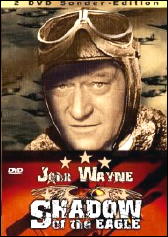
SHADOW OF THE EAGLE. Mascot, 12 episode serial, 1932. John Wayne, Dorothy Gulliver,Kenneth Harlan, Walter Miller, Edward Hearn, Richard Tucker, ‘Little Billy’ (Rhodes), Ivan Linow, James Bradbury Jr. Directors: Ford Beebe & B. Reeves Eason (the latter uncredited).
Shadow of the Eagle was John Wayne’s first Serial and a highly enjoyable effort, in its own way, for those prepared to spend four-and-a-half hours of their Precious Youth with a low-budget, low-brow movie no one ever heard of.
According to Tuska’s book on Mascot, the Duke was offered more money at this time to appear in Nothing Parts for major studios, but he wanted to play Hero Parts, and Nat Levine, King of Cheap Thrills in the early Thirties, told him it was a Lindbergh-type part.
He signed on, and the next day was carted off in the wee small hours of the morning to arrive at some remote location in time to start shooting at Dawn. (Mascot paid their Actors bv the day and in order to economize they started filming with the first Light of day and often didn’t finish till Midnight.)
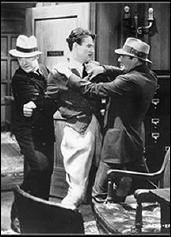
It was a career gamble that paid off, but there must have been times when Wayne wondered about it, what with long days, grueling conditions and short pay.
Whatever the case, Levine managed to churn out three highly entertaining serials over the next year with his new star before the Duke left for the Wide Open Spaces at Monogram.
Shadow of the Eagle concerns itself with the efforts of the mysterious “Eagle” to blackmail the Directors of an Aircraft Factory and cast the blame on an innocent Circus Owner, who happens to be the Heroine’s father and Duke’s employer.
John is allegedly a stunt-flier here, but the closest he probably ever got to a plane in this thing was watching the grainy old stock-footage of Mascot’s Bi-Plane and being chased across a field by it in a scene that looks to have inspired North by Northwest.
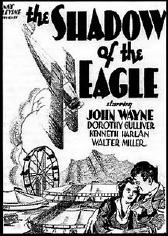
Still, it’s an entertaining film, in its way, with Wayne or some other sympathetic character apparently getting killed off at the end of each chapter, only to be miraculously “saved” in the opening of the next installment — often by the most outrageous cheating or unlikely contrivance.
There’s even some convincing Circus atmosphere, with various carnival denizens coming to the rescue at odd moments, including Ivan Linow as the Strong Man, James Bradbury Jr. as a rubber-limbed ventriloquist and Little Billy as — you guessed it.
Watching this thing, I find myself consistently amazed by the sheer quantity (if not Quality) of Thrills that Levine managed to pack in his film for peanuts. The Mascot serials may be a long way from Artistry, but they have an un-self-conscious innocence and energy that I find totally captivating.
Mon 26 Apr 2010
A MOVIE REVIEW BY DAVID L. VINEYARD:
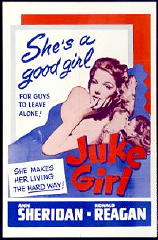
JUKE GIRL. Warner Brothers, 1942. Ann Sheridan, Ronald Reagan, Richard Whorf, George Tobias, Gene Lockhart, Alan Hale, Howard da Silva, Donald McBride, Faye Emerson, Fuzzy Knight, Willie Best. Screenplay by A.I. Bezzerides, based on a story by Theodore Pratt, adapted by Kenneth Gamet. Directed by Curtis Bernhardt.
History adds a touch of irony to this Warners social drama since in it Conservative icon and Republican President Ronald Reagan plays a radical left wing itinerant farm organizer, sort of an Anglo Cesar Chavez.
It’s the depths of the Depression and Reagan and pal Whorf have just wandered into the farming town of Cat Tail, California (“population 3,000 nine months a year, 30,000 the other three”) where shipper Gene Lockhart and his tough manager Howard da Silva are using their monopoly to break the farmers, like Greek George Tobias.
Whorf takes a job with Lockhart, but Reagan sticks up for Tobias and thus is set up a classic rivalry between buddies — pal against pal.
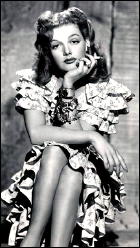
Enter Ann Sheridan, the dance hall girl of the title (a ‘Juke Girl’), a tough brassy broad who is no better than she has to be and not as bad as her face is painted — a typical Sheridan role, and a typical Warners leading lady — smart, self sufficient, tough, but with a heart of gold, and more morals than she lets on.
She and Reagan only need one look and the sparks fly (“You been burnin’ to get out of everywhere you ever been,” Reagan tells her). They teamed again more effectively in the classic King’s Row, but this one is closer to B territory, and they have more fun with it.
Reagan takes up with trucker Alan Hale, a two-fisted fellow also battling Lockhart and da Silva to help get Tobias and the other farmers in the cooperative’s crops to market — I told you this was an ironic role for Reagan — but Lockhart murders Tobias and frames Reagan and Sheridan for it.
As the lynch mob marches on the jail to take the lovers, Whorf and Hale coerce a confession from Lockhart, and save the lovers. Reagan and Sheridan end up with their own farm, Lockhart goes to jail, Hale is now in charge of helping the farmers, and Whorf hits the road again — but he’ll see them in nine months when the crops come in.
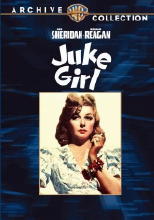
Reagan’s “Maybe I just don’t like to see a man kicked around,” is no Tom Joad’s speech from The Grapes of Wrath, but Sheridan has ‘oomph’ to spare, and if she is a thousand times better looking than the best looking dance hall girl who ever went to bed complaining about her aching feet, she had real skill at playing the kind of tough, human, and believable women Hollywood films too often turned into cliches.
Claire Trevor and Barbara Stanwyck were among the rare actresses who did it as well. Their working women had a way of making you think you might actually find them in a diner or dance hall — however unlikely that might be in real life.
Juke Girl lacks the righteous anger of Grapes of Wrath and the tragic eloquence, nor is it as emotionally tough as other Warners social drama classics such as I Was A Fugitive From a Chain Gang and Black Fury or the bright comedy/drama of films like Manpower, Slim or They Drive By Night. It’s also lacking a Paul Muni, Edward G. Robinson, James Cagney, or even George Raft, though Whorf does well in the Raft role in the film.
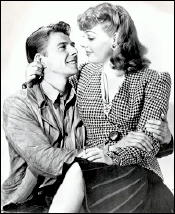
Reagan is a perfectly good lead, but he lacks the passion or the conviction this one calls for, the quiet dignity of a Henry Fonda, the caged power of a Cagney, or the depth and anguish of a Paul Muni — you keep half expecting him to mount a plough horse and ride off into a Republican sunset — exit stage right, of course. (In all fairness this was probably less a stretch before we knew his politics).
The film gets a good deal of good will though from fine contributions by Hale, Lockhart, da Silva, Tobias, Willie Best, and particularly from Sheridan’s famous ‘oomph.’ Whenever she is on screen, the film sparkles and threatens to become something more than what it is.
Juke Girl doesn’t have the head or the heart to be what it wanted to be, though it at least has the ambition to be something more. The seeds have been sewn, but all they bear are the grapes of mild indignation. It needed John Steinbeck and John Ford to turn social injustice into an American tragedy. Here we have a western with trucks and crops substituting for horses and cattle.
Mon 26 Apr 2010
Posted by Steve under
Reviews[7] Comments
IT IS PURELY MY OPINION
Reviews by L. J. Roberts
M. C. BEATON – Death of a Witch. Reprint paperback: Grand Central Publishing, January 2010. Hardcover edition: February 2009.
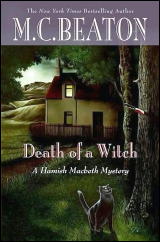
Genre: Police procedural/cozy. Series character: Hamish Macbeth, 25th in series. Setting: Scotland.
First Sentence: Police Constable Hamish Macbeth, heading home to his police station in the village of Lochdubh n Sutherland, heaved a sigh of relief.
Constable Hamish Macbeth is back in the Scottish village of Lochdubh after his less-than-restful vacation to Spain. He is greeted with the news that a witch has moved into town. But she’s not there long and she is murdered shortly after Hamish’s return. As Hamish’s investigation proceeds more die.
The Hamish books lie somewhere between traditional mysteries and cozies. On the traditional side, by the end of the book there are a lot of bodies and the protagonist is a policeman. However, rather than there being a detailed investigation, it’s almost as if, when Hamish appears, people confess and everything falls into place.
On the cozy side, there is an awful lot of time spent dealing with his relationships with women. He has better relationships with his pets. As for characters, Hamish is a little too good to be true. He’s tall, red-haired, good looking to the point where every woman but the one he wants throws themselves at him, and can run like the wind.
I was a bit annoyed that Hamish’s superior, CI Blair, is portrayed as so incompetent but at least it’s balanced by Hamish’s friend, DS Jimmy Anderson, and Blair’s boss, CS Davoit
The style is a bit simple for my taste, almost as if written for young adults. I do like that the dialogue is written with an indication of people’s accents without it becoming laborious.
The element I most enjoyed was the sense of place. Beaton’s descriptions of the highlands and the weather, which can be a critical element in living in, and navigating around, the highlands, is well done. This was a light, enjoyable read but it’s a series I’ve put behind me.
Rating: Good.
Editorial Comment: Say welcome to LJ Roberts and her first review for the Mystery*File blog. Her reviews previously graced the pages of both the printed version and the M*F website, but in the space of time between the latter and the blog, she moved them elsewhere, but only temporarily, I’m pleased to say. Here she is again.
Wed 21 Apr 2010
I don’t know if you’ve noticed, but I’ve jammed a sizable number of posts into the span of the last two or three days. Ordinarily I might have been spread them out over a longer period of time, but something’s up. Soon after noon tomorrow, I’ll be on my way to Chicago and this year’s annual Windy City Pulp & Paper Convention.
And I won’t be back until Sunday, with my satchels full of books and magazines and my checkbook empty. Heck, if I plan it right, my checkbook will be empty several minutes after the doors to the dealers’ room open on Friday. It won’t be hard to do, especially with all the wares that’ll be out for display, fully designed to tickle everyone’s fancy. Well, mine, at least.
Some of you I will see there, I am sure. If not, so long until next week Monday. For the rest of this evening, it’s time to pack.
Wed 21 Apr 2010
FORBIDDEN. British Lion Film Corp, UK, 1948. Douglass Montgomery, Hazel Court, Patricia Burke, Garry Marsh, Ronald Shiner, Kenneth Griffith. Director: George King.
By sheerest of chances, one imagines, I’ve come across both an episode of a TV show (Adam Adamant Lives) and a movie (Forbidden) which takes place along the “Golden Mile,” a stretch of Promenade between the North and South piers in Blackpool, England, filled (in its heyday) with carnival booths and amusement arcades, slot machines and various other means of taking money from the pockets of passers-by.

The episode (Adam Adamant Lives) was the second of the series, “Death Has a Thousand Faces” (30 June 1966), in which Adamant (Gerald Harper) and Georgina Jones, his female assistant (Juliet Harmer) meet and recruit the third member of the program’s recurring cast, a barker by the name of William Simms (Jack May). Unaccountably, Simms does not appear in the third episode, reflecting some of the production problems the TV crew were having at the time.
But this is not a review of Adam Adamant, nor of the Golden Mile, but of Forbidden, in which one actor on the way down, Douglass Montgomery – this was his last movie before heading over to solely a television career – meets one on the way up, Hazel Court, red-headed beauty of many a later Hammer horror film, several years in her future yet.
She’s the girl behind a candy counter along the Golden Mile, and across the way is Montgomery’s booth, in which he sells tonics of all sorts for all kinds of maladies – a sort of stationary medicine wagon. Baldness, sore feet, upset stomach? Stop in, please.
But it must pay well. Jim Harding (that’s his name) could be a research chemist instead, and for real, but his wife, determined to become an actress, has a standard of living that demands he say no to mere (and low-paying) academic pursuits.
The girl’s name is Jane Thompson (played by Hazel Court) and she’s not his wife, but she’d like to be. But don’t get the wrong impression here. She’s an innocent and doesn’t know that he’s even married. But he does — boy does he ever — and here is where the noir aspect of this relatively mild British thriller kicks in.
Harding is a weakling, though, though not strictly in a physical sense. Maybe mild-mannered is a sufficient description — not a forceful fellow at all. Things do take their course, however, and after his wife’s death and a suspenseful chase scene taking place in the tower high above the promenade, there is a happy ending – or at least an ending that’s as happy as it could be, given the circumstances.
I’ve used the word “mild” a couple of times. As thrillers go, that just about sums this movie up in one word: mild. The presence of Hazel Court in this movie was enough to keep me watching it, even in black and white. She may, or may not, be reason enough for you.
[UPDATE.] 04-22-10. While the DVD cover shown is that of the UK edition, I thought I should let you know that Forbidden has been commercially released in the US also, and that’s the copy I have.
Wed 21 Apr 2010
REVIEWED BY DAN STUMPF:
TOM WEST – Ghost Gold. E. P. Dutton “Diamond D Western,” hardcover, 1950. Reprint paperback: Pocket #733, October 1950.
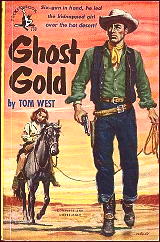
I almost pitched Ghost Gold after the first few pages: the local bank is found robbed, a teller murdered, and a handsome stranger on the floor, unconscious, with the murder weapon in his hand.
Well, it’s perfectly obvious he can’t be the killer, and equally obvious that someone’s going to walk his horse out from under him if he can’t prove his innocence. Looked like pretty standard stuff, and I didn’t feel like spending a whole book plodding toward the obvious.
Fortunately, neither did the author, Tom West.. In short order our hero is cleared of the crime and on the track of the guilty owlhoots what done it. Which is also fairly standard stuff for a western, except that this one is peppered with a saucy supporting cast that livens up even a plot as stale as this one.
West throws in a corrupt lawman with a stubborn streak, colorful heroine, drunken lawyer, doughty squatters, and best of all, a colorful detective, Scripture Sam, who goes about methodically collecting clues and sifting evidence in the best tradition, while mis-quoting the Bible and ventilating side-winders.
Ghost Gold is worth reading just for this, but it also offers a few well-paced chases, gun-battles and a dandy wrap-up for the hombres. In all, a lively time and I’m glad I stuck with it.
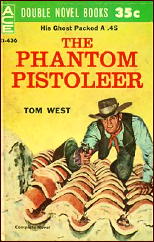
Editorial Comments: Tom West is not an author who’s remembered very much today, even, I suspect, by most collectors and connoisseurs of western fiction. But between 1944 and 1980 he wrote some 60 plus western novels, most of them as paperback originals, many by Ace in their “Double Novel” format.
Of special note, I think, is the fact that he favored alliterative titles, ones such as Meddling Maverick (his first), Bushwhack Basin, Battling Buckaroos, Lobo Lawman, The Toughest Town in the Territory, and Bad Blood at Bonita Basin. Plus Ghost Gold as well, of course.
I have a complete checklist of his westerns to post online, and I will, as soon as I can get to it, perhaps as early as next week.
« Previous Page — Next Page »










